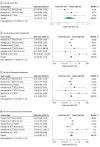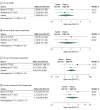COVID-19 Pandemic and Infant Neurodevelopmental Impairment: A Systematic Review and Meta-analysis
- PMID: 36306133
- PMCID: PMC9617178
- DOI: 10.1001/jamanetworkopen.2022.38941
COVID-19 Pandemic and Infant Neurodevelopmental Impairment: A Systematic Review and Meta-analysis
Abstract
Importance: Primary studies proposed that aberrant maternal antiviral immunity and/or giving birth in quarantine, such as during the ongoing COVID-19 pandemic, may be associated with the risk of neurodevelopmental impairment (NDI) in offspring.
Objectives: To evaluate the associations of birth and being raised during the COVID-19 pandemic with risk of NDI among infants and to assess the association of gestational exposure to SARS-CoV-2 with risk of NDI.
Data sources: PubMed, Web of Science, Scopus, Embase, and preprint servers were systematically searched from inception to March 25, 2022.
Study selection: Studies evaluating the neurodevelopment of infants born during the SARS-CoV-2 pandemic were included in this systematic review and meta-analysis. Studies using Ages and Stages Questionnaires, Third Edition (ASQ-3), were used for quantitative meta-analysis.
Data extraction and synthesis: Following the Preferred Reporting Items for Systematic Reviews and Meta-analyses, a random-effects model meta-analysis was used to pool the proportion and odds ratios (ORs) of overall NDI, as well as each developmental domain on ASQ-3 with the corresponding 95% CI.
Main outcomes and measures: The primary outcome was the risk of overall NDI among infants screened during the pandemic vs prepandemic. The secondary outcome was the comparison of NDI by ASQ-3 domain among infants born to women with known gestational exposure to SARS-CoV-2 vs no exposure.
Results: A total of 8 studies were included, including 21 419 infants (11 438 screened in pandemic and 9981 in prepandemic period). NDI was present in 330 of 8992 infants (7%; 95% CI, 4%-10%) screened during the COVID-19 pandemic from January 2020 to January 2021. Among the pandemic cohort, the prevalence of NDI among infants with gestational exposure to SARS-CoV-2 was 77 of 691 (12%; 95% CI, 6%-18%). Compared with the prepandemic cohort (2015-2019), the pandemic cohort was more likely to have communication impairment (OR, 1.70; 95% CI, 1.37-2.11; P < .001), without significant differences in other ASQ-3 domains (eg, gross motor, fine motor, personal-social, and problem-solving). In contrast, maternal SARS-CoV-2 infection was not associated with significant differences in any neurodevelopment domain in offspring, except for increasing the odds of fine motor impairment (OR, 3.46; 95% CI, 1.43-8.38; P < .001).
Conclusions and relevance: In this systematic review and meta-analysis examining the association between COVID-19 pandemic and the risk of NDI, findings suggest that overall neurodevelopment in the first year of life was not changed by either being born or raised during the SARS-CoV-2 pandemic or by gestational exposure to SARS-CoV-2. Interestingly, the first year of life during the COVID-19 pandemic, regardless of maternal infection, was significantly associated with the risk of communication delay among the offspring.
Conflict of interest statement
Figures




Comment in
-
Low Risk of Neurodevelopmental Impairment in the COVID-19 Generation Should Not Make Researchers Complacent.JAMA Netw Open. 2022 Oct 3;5(10):e2238958. doi: 10.1001/jamanetworkopen.2022.38958. JAMA Netw Open. 2022. PMID: 36306137 No abstract available.
References
-
- US Centers for Disease Control and Prevention . COVID-19 during pregnancy. 2022. Accessed April 1, 2022. https://www.cdc.gov/coronavirus/2019-ncov/cases-updates/special-populati...
-
- Allotey J, Stallings E, Bonet M, et al. ; for PregCOV-19 Living Systematic Review Consortium . Clinical manifestations, risk factors, and maternal and perinatal outcomes of coronavirus disease 2019 in pregnancy: living systematic review and meta-analysis. BMJ. 2020;370:m3320. doi:10.1136/bmj.m3320 - DOI - PMC - PubMed
Publication types
MeSH terms
LinkOut - more resources
Full Text Sources
Medical
Miscellaneous

